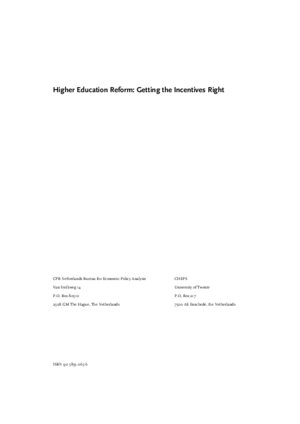Higher education reform; getting the incentives right; a joint product of the Netherlands Bureau for Economic Policy Analysis (CPB) and the Center for Higher Education Policy Studies (CHEPS).
Deregulering van collegegelden kan hoger onderwijs efficiënter maken
We are sorry, unfortunately there is no English translation of this page.
Modern societies have an urgent need for highly skilled labour, not only to push ahead the technological frontier by creative researchers but also to adopt and diffuse existing knowledge.While this crucial role of higher education for economic growth is widely recognised, the way in which countries organise their higher education system differs vastly. Traditionally, the higher education sector is strongly intertwined with the public sector through an extensive system of regulation and financial support (direct and indirect). Apart from this very general common feature, countries differ in policies with respect to student selection, tuition feesstudent support programs, public funding of teaching and research, and so forth. This countryspecific nature of higher education reflects the fact that the university system is often deeply embedded into a nation’s history and culture. Only recently some countries have begun to revisit the role of government. This development was spurred by the tightening of fiscal constraints on public outlays in most OECD countries, which forced governments to rethink their task in(virtually) all sectors they are involved in.
The Netherlands forms no exception. There is an ongoing debate on the function of higher education in the society at large, and the role of the various stakeholders in the higher education sector, including the government, the higher education institutions, students and the private sector. The current debates in the Netherlands concern a wide range of issues.
- First of all, within the perspective of the “knowledge economy” it is claimed that there is a sheer need for highly skilled graduates who are employable in a broad spectrum of jobs. On the other hand, there is an ongoing concern that too few students attend programs in engineering or natural sciences. This calls for a discussion on private and social returns to education, and on the appropriateness and efficiency of government policies to influence the mix of graduates.
- A second category of issues is concerned with access to higher education. In this perspective, we particularly mention the continuous debates on the level of tuition fees, changes in the student support system and the way to assign student slots for programs with restricted capacity;
- A third issue addresses the relation between diversity and transparency in the higher education sector. To improve transparency on the international higher education market, institutions are reforming their study programs towards the Bachelor-Master model. This should also contribute to international labour mobility, as the range of qualifications offered become more transparentto foreign employers. However, in competing for students, higher education institutions are trying to distinguish themselves by means of differentiation – in terms of programs, duration, modes of delivery (applying new technologies), target groups and the academic quality of their programs. Related to this is the issue of quality assurance, including the accreditation of programs (or higher education institutions);
- Fourth, and finally, there is a growing tendency to include market-type mechanisms as a coordinating device in the higher education system. Providers are supposed to become more competitive and accountable. For instance, the funding of education and research is increasingly becoming performance-based. In addition, in a period when public funds are not keeping up with growing student numbers, the higher education institutions become increasingly inclinedto look for additional sources of revenue. This has resulted in more contract activities and increased public-private cooperation.
This book aims to provide a helicopter view on options to organise higher education systems. It is, however, impossible to elaborate on all the above-mentioned issues in this study. Therefore, we have to limit ourselves – both in terms of the perspective we take and the issues we look at – even though we realise that many of the issues are interrelated. To that end, particular attention is paid to the institutional setting in which the higher education sector is operating. Often, this means a close inspection of the incentive structure. It would be too narrow, though, to merely focus on high-powered economic or financial incentives. Financial incentives may have adverse and unintended effects when people are intrinsically motivated in their work, as these incentivescould trigger a shift toward activities that generate measurable output while important other activities that generate hard-to-measure output are crowded out. Since the Dutch experience with alternative arrangements in the higher education system is limited, we shall look across the borders and try to learn from experiences in other countries. Again, the organisation of the higher education system should be seen in the context of the specific institutional setting: systems of higher education successful in one country may fail in another. A critical evaluation thus requires a more profound understanding of the specific institutional structure in those countries
